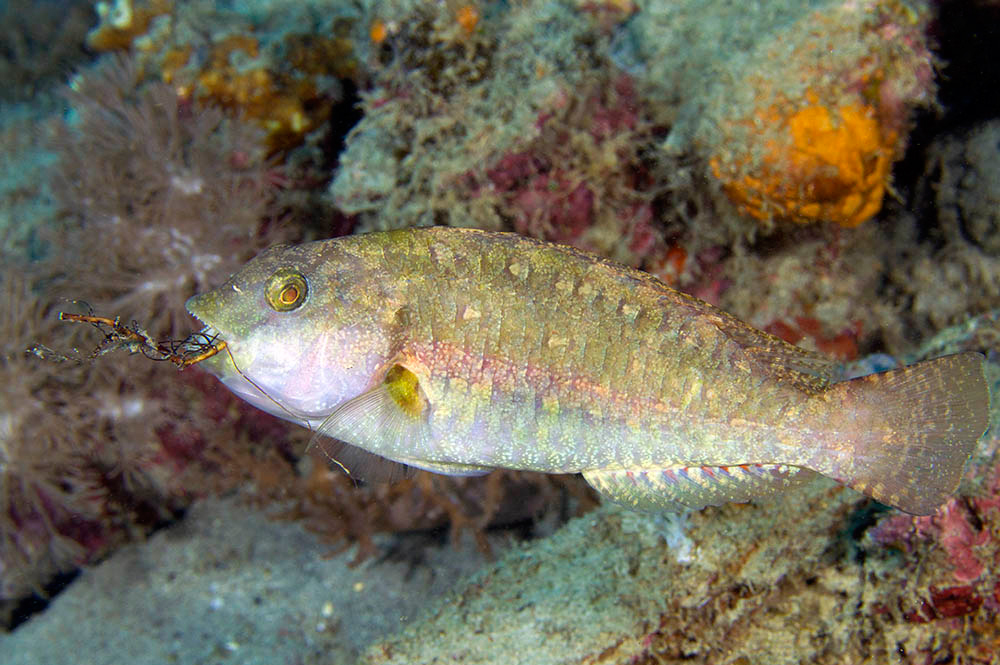- Classification
- ACTINOPTERYGII
- PERCIFORMES
- LABRIDAE
- Leptoscarus
- vaigiensis
Marbled Parrotfish, Leptoscarus vaigiensis (Quoy & Gaimard 1824)
Other Names: Blue-spotted Parrotfish, Marbled Parrot-fish, Slender Parrotfish

A Marbled Parrotfish, Leptoscarus vaigiensis, at Puerto Galera, Philippines. Source: Paddy Ryan / http://www.ryanphotographic.com/. License: All rights reserved
Summary:
A mottled greenish or olive brown wrasse. Males and females are similar in coloration, with males having a whitish midlateral stripe.
Cite this page as:
Bray, D.J. 2025, Leptoscarus vaigiensis in Fishes of Australia, accessed 01 Jul 2025, https://fishesofaustralia.net.au/home/species/398
Marbled Parrotfish, Leptoscarus vaigiensis (Quoy & Gaimard 1824)
More Info
|
Distribution |
Recorded in Australia from Rottnest Island, Western Australia, around the tropical north, to Sydney, New South Wales; also Cocos (Keeling) Islands in the eastern Indian Ocean, and the Lord Howe Province and Norfolk Island in the Tasman Sea. Elsewhere the species is widespread in the Indo-Pacific, from the northern Red Sea and South Africa to Pitcairn Island in the Central Pacific, north to southern Japan, south to the Poor Knight's Island in New Zealand and Rottnest Island in Australia. Although widespread in the Indo-Pacific region, the Marbled Parrotfish is relatively rare in most parts of its range. Inhabits seagrass beds and algal-covered reefs in sheltered bays, harbours and lagoons. |
|
Features |
Dorsal fin IX, 10; Anal fin III, 9; Pectoral fin 13; Vertebrae 25. Body relatively elongate, depth 2.9-3.8 in SL; median predorsal scales 3-4; 1 scale row on cheek, 1(4), below eye; unique narrow dental plates composed of numerous small teeth. |
|
Feeding |
Feeds on seagrasses and algae. |
|
Biology |
Marbled Parrotfish usually occur in small groups. Unlike other parrotfishes, males and females look very similar and do not change sex. Larvae of this species is associated with drifting algae. |
|
Etymology |
The species is named for the type locality, Vaigiou (= Pulau Waigeo), Papua Barat, Indonesia, (the suffix -ensis, denotes a place). |
|
Species Citation |
Scarus vaigiensis Quoy & Gaimard, 1824, Voyage autour du Monde 1: 288. Type locality: Vaigiou [= Pulau Waigeo, Papua Barat, Indonesia] |
|
Author |
Bray, D.J. 2025 |
|
Resources |
Marbled Parrotfish, Leptoscarus vaigiensis (Quoy & Gaimard 1824)
References
Allen, G.R. 1997. Marine Fishes of Tropical Australia and South-east Asia. Western Australian Museum. 292 pp.
Allen, G.R. & Erdmann, M.V. 2012. Reef fishes of the East Indies. Perth : Tropical Reef Research 3 vols, 1260 pp.
Allen, G.R. & Smith-Vaniz, W.F. 1994. Fishes of Cocos (Keeling) Islands. Atoll Research Bulletin 412: 1-21
Allen, G.R. & R. Swainston. 1988. The Marine Fishes of North-Western Australia. A Field Guide for Anglers and Divers. Western Australian Museum. 201 pp.
Bellwood, D.R. 1994. A phylogenetic study of the parrotfishes family Scaridae (Pisces: Labroidei), with a revision of genera. Records of the Australian Museum, Supplement 20: 1-86.
Bellwood, D.R. 2001. Scaridae. pp. 3468-3492 in Carpenter, K.E. & Niem, T.H. (eds) The Living Marine Resources of the Western Central Pacific. FAO Species Identification Guide for Fisheries Purposes. Rome : FAO Vol. 6 pp. 3381-4218.
Bellwood, D.R. & Choat, J.H. 1989. A description of the juvenile phase colour patterns of 24 parrotfish species (family Scaridae) from the Great Barrier Reef, Australia. Records of the Australian Museum. 41: 1-41.
Bruce, R.W. & Randall, J.E. 1985. A revision of the Indo-West Pacific parrotfish genera Calotomus and Leptoscarus (Scaridae: Sparisomatinae). Indo-Pacific Fishes 5: 1-32.
Francis, M. 1993. Checklist of the coastal fishes of Lord Howe, Norfolk, and Kermadec Islands, southwest Pacific Ocean. Pacific Science 47(2): 136-170 figs 1-2
Larson, H.K., Williams, R.S. & Hammer, M.P. 2013. An annotated checklist of the fishes of the Northern Territory, Australia. Zootaxa 3696(1): 1-293.
Quoy, J.R.C. & Gaimard, J.P. 1824. Chapter 8. Poissons. 183-328 pls 43-65 in Freycinet, L.C.D. de (ed.) Voyage autour du Monde, entrepris par ordre du Roi, exécuté sur les corvettes de S.M. Uranie et la Physicienne, pendant les années 1817, 1818, 1819 et 1820. Paris : Pillet Aîné Vol. 1 712 pp. 96 pls.









